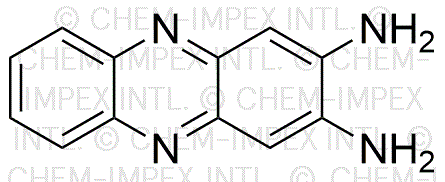Phenazine-2,3-diamine is widely utilized in research focused on:
- Electrochemical Sensors: This compound is often used in the development of electrochemical sensors for detecting various analytes, including glucose and other biomolecules, due to its excellent electron transfer properties.
- Antimicrobial Agents: It has shown potential as an antimicrobial agent, making it valuable in the pharmaceutical industry for developing new treatments against resistant bacterial strains.
- Organic Electronics: In the field of organic electronics, it serves as a key component in organic light-emitting diodes (OLEDs) and organic photovoltaic cells, enhancing their efficiency and stability.
- Fluorescent Dyes: The compound is utilized in creating fluorescent dyes for biological imaging, allowing researchers to visualize cellular processes with high precision.
- Research in Cancer Therapy: Studies indicate its potential role in cancer therapy, where it may contribute to the development of novel chemotherapeutic agents that target specific cancer cells.
General Information
Properties
Safety and Regulations
Applications
Phenazine-2,3-diamine is widely utilized in research focused on:
- Electrochemical Sensors: This compound is often used in the development of electrochemical sensors for detecting various analytes, including glucose and other biomolecules, due to its excellent electron transfer properties.
- Antimicrobial Agents: It has shown potential as an antimicrobial agent, making it valuable in the pharmaceutical industry for developing new treatments against resistant bacterial strains.
- Organic Electronics: In the field of organic electronics, it serves as a key component in organic light-emitting diodes (OLEDs) and organic photovoltaic cells, enhancing their efficiency and stability.
- Fluorescent Dyes: The compound is utilized in creating fluorescent dyes for biological imaging, allowing researchers to visualize cellular processes with high precision.
- Research in Cancer Therapy: Studies indicate its potential role in cancer therapy, where it may contribute to the development of novel chemotherapeutic agents that target specific cancer cells.
Documents
Safety Data Sheets (SDS)
The SDS provides comprehensive safety information on handling, storage, and disposal of the product.
Product Specification (PS)
The PS provides a comprehensive breakdown of the product’s properties, including chemical composition, physical state, purity, and storage requirements. It also details acceptable quality ranges and the product's intended applications.
Certificates of Analysis (COA)
Search for Certificates of Analysis (COA) by entering the products Lot Number. Lot and Batch Numbers can be found on a product’s label following the words ‘Lot’ or ‘Batch’.
*Catalog Number
*Lot Number
Certificates Of Origin (COO)
This COO confirms the country where the product was manufactured, and also details the materials and components used in it and whether it is derived from natural, synthetic, or other specific sources. This certificate may be required for customs, trade, and regulatory compliance.
*Catalog Number
*Lot Number
Safety Data Sheets (SDS)
The SDS provides comprehensive safety information on handling, storage, and disposal of the product.
DownloadProduct Specification (PS)
The PS provides a comprehensive breakdown of the product’s properties, including chemical composition, physical state, purity, and storage requirements. It also details acceptable quality ranges and the product's intended applications.
DownloadCertificates of Analysis (COA)
Search for Certificates of Analysis (COA) by entering the products Lot Number. Lot and Batch Numbers can be found on a product’s label following the words ‘Lot’ or ‘Batch’.
*Catalog Number
*Lot Number
Certificates Of Origin (COO)
This COO confirms the country where the product was manufactured, and also details the materials and components used in it and whether it is derived from natural, synthetic, or other specific sources. This certificate may be required for customs, trade, and regulatory compliance.

